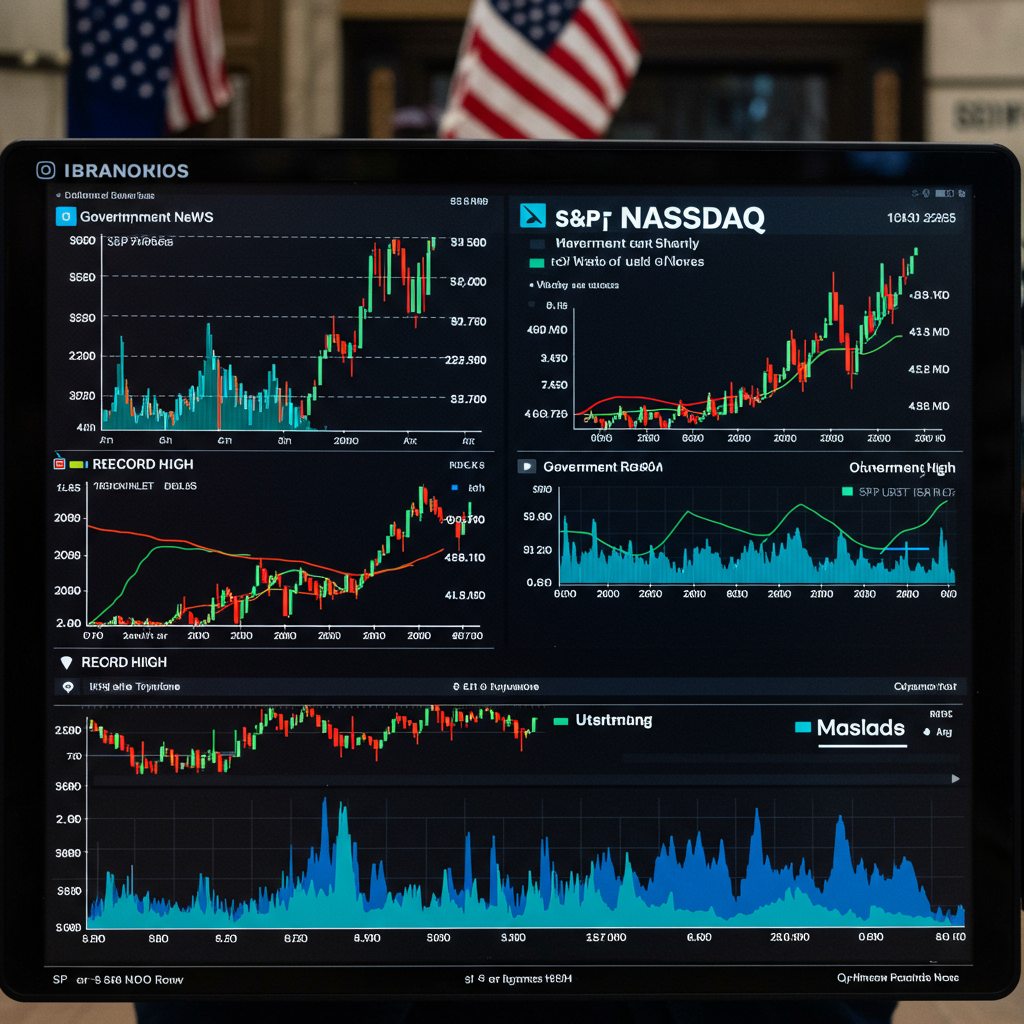The US stock market delivered a dynamic performance as late September 2025 unfolded. Investors closely watched the S&P 500 and Nasdaq Composite indices, which experienced periods of significant climbing, even hitting fresh record highs. This upward momentum often occurred despite, or sometimes because of, a looming government shutdown threat. Wall Street grappled with conflicting economic signals and a highly anticipated Federal Reserve policy path. This complex environment underscored a market driven by both corporate innovation and macroeconomic uncertainty.
Navigating Market Dynamics Amidst Political Tensions
On a notable day this period, the stock market today saw both the S&P 500 and Nasdaq climb. The tech-heavy Nasdaq led these gains, often reaching new record closes. Investors largely celebrated this rally, particularly the resilience of major technology stocks. However, this optimism coexisted with persistent concerns about a potential government shutdown. Such a shutdown could disrupt economic activities and dampen investor sentiment. Historically, government shutdowns introduce uncertainty, potentially impacting consumer confidence and federal operations. This political backdrop added a layer of caution to an otherwise buoyant market.
The Shadow of a Government Shutdown
A potential US government shutdown remained a significant focal point for investors. This threat often triggers anxieties about future economic stability. Markets tend to dislike uncertainty, and a shutdown could introduce delays in economic data releases. It might also halt non-essential government services, causing ripple effects across various sectors. While the market frequently showed resilience, the ongoing political discussions heavily influenced daily trading decisions. Traders carefully monitored Washington, aware that any resolution or escalation could quickly shift market momentum.
The Federal Reserve’s Pivotal Role and Economic Data
The Federal Reserve’s monetary policy remained a central theme driving market behavior. Chairman Jerome Powell’s remarks at Jackson Hole earlier in the month were particularly impactful. He hinted at a potential September interest rate cut, significantly boosting investor confidence. Powell suggested that evolving economic risks might justify adjusting the policy stance. This outlook immediately fueled bets on easing monetary conditions, leading to widespread market gains.
However, the path to rate cuts wasn’t straightforward. Stronger-than-expected economic data occasionally complicated the narrative. Robust job figures and a resilient GDP growth could reduce the perceived urgency for the Fed to lower rates. This created a delicate balance: positive economic news sometimes led to market slides if it implied fewer rate cuts.
Labor Market Shifts and Inflationary Pressures
Recent labor market data provided conflicting signals. A substantial downward revision showed 911,000 fewer jobs added than previously thought through March 2025. This significant weakness in the labor market strengthened arguments for a rate cut. Similarly, the JOLTS report revealed July job openings below expectations. These indicators of a slowing labor market fueled expectations for a 25-basis-point cut in September, with high probabilities priced in by traders.
Looking ahead, investors eagerly awaited crucial inflation reports. The Producer Price Index (PPI) and Consumer Price Index (CPI) were key gauges. These readings would determine if rising prices could hinder deep or sustained rate cuts. The Personal Consumption Expenditures (PCE) index, the Fed’s preferred inflation measure, was also on watch. These reports were expected to offer fresh insights into the Fed’s next moves.
Big Tech Powering Gains and Corporate Highlights
Throughout this period, the “Magnificent Seven” tech giants continued to wield immense influence. Their performance often dictated the direction of the broader S&P 500 and Nasdaq indices.
Key tech stock movements included:
Nvidia (NVDA) surged to new records. This was driven by a massive $100 billion investment pledge in OpenAI, the developer of ChatGPT. Nvidia’s pivotal role in AI infrastructure continued to propel its valuation.
Apple (AAPL) rebounded, erasing its 2025 losses. Analyst upgrades, anticipation for the iPhone 17 lineup, and potential collaborations with Google for a revamped Siri boosted its stock.
Oracle (ORCL) saw its shares jump. Confirmation of its central role in TikTok’s US operations provided a significant catalyst. Oracle was tasked with inspecting and retraining TikTok’s algorithm on US user data.
Tesla (TSLA) experienced mixed fortunes. While investors anticipated its self-driving future, the company faced challenges. European EV sales declined for the eighth consecutive month. Stiff competition from Chinese EV makers also weighed on its performance.
Intel (INTC) jumped on reports of potential Apple investment and a 10% stake acquisition by the US government. This was seen as a move to stabilize its struggling US manufacturing business.
IBM (IBM) shares rose after HSBC reported significant reductions in algorithm errors. This was achieved by integrating IBM’s Quantum Heron quantum computers into bond trading.
- ASML (ASML), a critical AI chipmaking machinery producer, received an analyst upgrade. This highlighted increased AI-driven demand and strengthening memory chip orders.
- finance.yahoo.com
- finance.yahoo.com
- finance.yahoo.com
- finance.yahoo.com
- finance.yahoo.com
Beyond tech, other corporate news also moved the markets. Macy’s (M) soared after beating earnings estimates and raising its outlook. Pfizer (PFE) announced a major acquisition of weight-loss drug developer Metsera. Conversely, CarMax (KMX) slid after missing Q2 earnings, and Starbucks revealed plans for job cuts and store closures amid ongoing struggles.
Sectoral Spotlights: Energy, Nuclear, and Retail
Certain sectors experienced distinct movements during this dynamic period. The Energy Sector (XLE) often led gains within the S&P 500. Rising oil prices, partly due to geopolitical events such as an Israeli strike on Qatar, bolstered companies like Chevron and Exxon Mobil. Exxon Mobil also ventured into energy storage by acquiring a battery factory.
Nuclear energy companies like Constellation Energy (CEG) and Vistra (VST) also rallied significantly. Soaring demand for data center power, intensified by Nvidia’s AI investments, fueled optimism in this sector.
In retail, a mixed picture emerged. Ross Stores (ROST) jumped as consumers sought discounts amidst tariff pressures. Costco (COST) was expected to report strong sales as shoppers focused on value. However, Dollar Tree (DLTR) saw its shares fall despite raising its annual forecasts.
Commodities and Cryptocurrencies: A Mixed Bag
The broader financial landscape also witnessed significant movements in commodities and cryptocurrencies. Gold (GC=F) experienced a remarkable rally, reaching fresh all-time highs above $3,750 per ounce. Projections even suggested it could surge toward $4,250. This surge was primarily driven by increased bets on Federal Reserve rate cuts and concerns about global debt. Silver also saw substantial gains, climbing over 55% year-to-date.
In contrast, Bitcoin (BTC-USD) and other major cryptocurrencies faced a challenging period. A sharp selloff occurred as traders liquidated significant bullish wagers. Bitcoin notably fell below $110,000, reflecting increased volatility and a cautious sentiment in the crypto market. This contrasted sharply with the strength seen in gold and silver, highlighting a flight to traditional safe-haven assets amidst market uncertainty.
Key Takeaways for Today’s Investor
The late September 2025 market environment underscored complex interplay of factors. Investors navigated a market buoyed by tech innovation yet challenged by macroeconomic uncertainty and political tensions. The potential for Federal Reserve rate cuts acted as a strong tailwind. However, robust economic data periodically tempered these expectations. The stock market today reflects a delicate balance. Understanding these underlying currents is crucial for making informed investment decisions. Keep a close eye on upcoming inflation data and any developments from Washington regarding a government shutdown.
Frequently Asked Questions
What factors are currently driving the US stock market’s fluctuating performance?
The US stock market in late September 2025 was primarily driven by a combination of Federal Reserve policy expectations, crucial economic data, significant corporate developments, and political uncertainties. Robust job reports and strong GDP growth complicated the outlook for interest rate cuts. Conversely, weaker labor market data, like job revisions and JOLTS figures, often fueled rate cut hopes. Major tech stocks, particularly those involved in AI, significantly influenced market rallies. The looming threat of a government shutdown also added a layer of caution, keeping investors on edge.
How might a potential government shutdown impact investor strategies in the near term?
A government shutdown introduces significant uncertainty and can impact investor strategies by increasing market volatility. It may delay the release of critical economic data, making it harder to assess market conditions accurately. Investors might shift towards more defensive sectors or safe-haven assets like gold. Companies with direct government contracts or those heavily reliant on federal services could face disruptions. Portfolio adjustments to mitigate risk and prioritize stability become key considerations until a resolution is reached.
What are the key economic indicators investors should monitor for future market direction?
Investors should closely monitor several key economic indicators to gauge future market direction, especially concerning Federal Reserve policy. The Personal Consumption Expenditures (PCE) index is the Fed’s preferred inflation gauge, and its monthly readings are critical. Additionally, the Consumer Price Index (CPI) and Producer Price Index (PPI) offer broad insights into inflationary pressures. Labor market data, including the monthly jobs report, jobless claims, and the JOLTS report (Job Openings and Labor Turnover Survey), are also vital for understanding the economy’s health and potential Fed actions.



